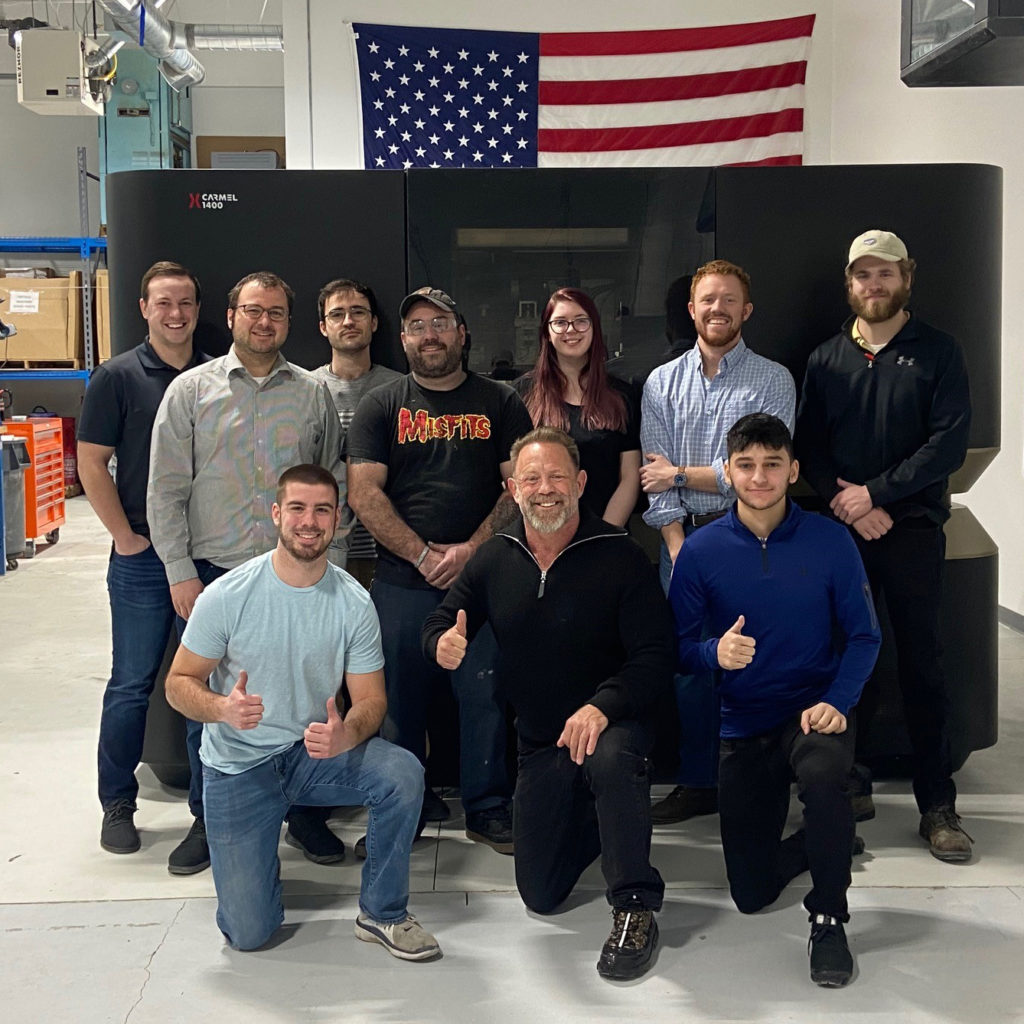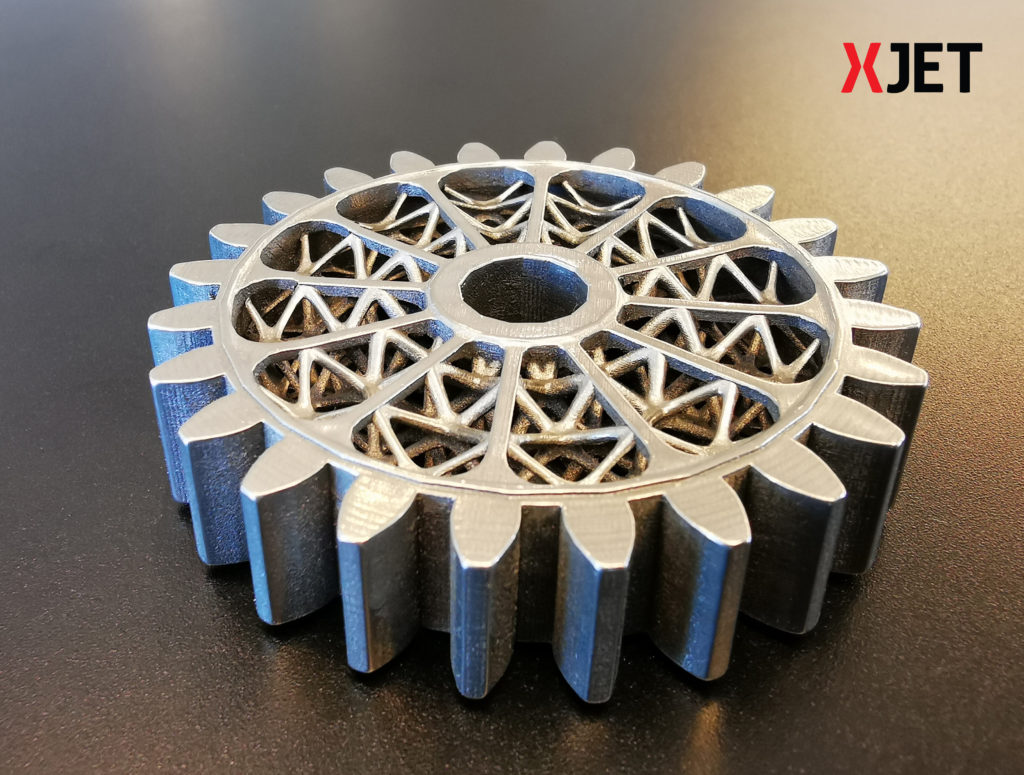After six years of anticipation, XJet has installed its first commercial metal 3D printer, the Carmel 1400M, with a customer. The customer? Additive manufacturing (AM) firm Azoth3D. XJet´s innovative NanoParticle Jetting (NPJ) technology allows users make metal and ceramic parts with high resolution and comparatively low post-processing. Though unique, it has taken some time for the metal version of its process to reach the market.

At a rate of 222 million drops per second, NPJ deposits a liquid suspension with solid nanoparticles, along with a dissolvable support material, onto a build platform in very thin layers. Once the green part is complete, the supports are removed and the component is sintered in a furnace, resulting in a dense, final part. The use of material cartridges means that the system is safer than powder bed fusion (PBF) alternatives, due to the lack of metal powder. This not only increases safety, but reduces operating costs. Additionally, NPJ produces parts with extremely high detail and, due to the use of dissolvable supports, can 3D print complex geometries, including open cavities that are impossible with PBF.
“We have developed the only metal AM technology available today based on the concept of direct material jetting. After an amazing success with the XJet ceramic systems, we are now ready for the bigger dream, bringing to the market our metal solution. It gives me great pleasure to know that our first user of the metal AM system is Azoth, with so much experience in metal manufacturing and in metal AM. Getting the recognition from such a market leader for the quality of parts we can make has made the entire journey, and the long wait for this system, worthwhile,” XJet CEO Hanan Gothait stated.
In the six years since XJet first began showcasing its technology at trade shows, the company was able to bring its ceramic machines to market and rather quickly compared to its metal counterparts. Its first global customer for its ceramic 3D printing system was Oerlikon in 2017, just a year after the public launch of its technology. This was followed by a number of notable customers, including Marvel Medtech, Straumann Group, the UK’s National Centre for Additive Manufacturing, and Syqe Medical. Now, the Israeli company is finally seeing the metal side of its business make it out to the world.
“We have a huge wealth of experience in metal manufacturing – with both additive and subtractive processes. XJet’s metal system delivers capabilities that are in high demand in the market, but are not achievable with other technologies.Parts with fine features, high resolution, good surface finish right off the printer – at a level we have not seen before. The ease-of-use and safety working with the XJet system, that does not involve handling powders, is another important factor for us,” Scott Burk, Azoth CEO says,
Azoth is a part of the EWIE group of companies (EGC) a large-scale supplier group that mostly caters to the automotive sector. Azoth3D hopes to use its TAKE ONE MAKE ONE (TOMO) methodology to offer a digital inventory, with only a single physical part in a warehouse. The moment someone orders a replacement, it will be made with metal 3D printing. The firm is bullish about this methodology, relying on metal printing for spares. It hopes that it can do both prototypes and manufacturing with the Carmel.

“My eureka moment came when we got some test parts through from XJet and I asked the team how they looked, and they responded that they were the best they’d ever seen. What we really liked were the small holes, very sharp corners, very refined surface finish without needing any post-processing. We’re also impressed with the science behind XJet’s NanoParticle Jetting™ technology. It prints with very small particles, smaller than other technologies. These characteristics allow for process advantages, smaller layer heights and smaller features,” said Cody Cochran, Azoth General Manager and Co-Founder.
You can see Azoth3D´s XJet Carmel 1400M live and in person on May 16th at RAPID, when you’re invited to take a little trip to Azoth’s Ann Arbor, Michigan facility to see the machine. I really have a soft spot for XJet and love the way it can provide high-resolution metal parts, potentially in bulk. I also love Azoth’s thinking here to find and commercialize relatively new technologies specifically for spare parts. I think that the firm could potentially be onto something and become the first player to digitize the spare parts toolchain in the U.S.
Subscribe to Our Email Newsletter
Stay up-to-date on all the latest news from the 3D printing industry and receive information and offers from third party vendors.
You May Also Like
Gorilla Sports GE’s First 3D Printed Titanium Cast
How do you help a gorilla with a broken arm? Sounds like the start of a bad joke a zookeeper might tell, but it’s an actual dilemma recently faced by...
Nylon 3D Printed Parts Made More Functional with Coatings & Colors
Parts 3D printed from polyamide (PA, Nylon) 12 using powder bed fusion (PBF) are a mainstay in the additive manufacturing (AM) industry. While post-finishing processes have improved the porosity of...
$25M to Back Sintavia’s Largest Expansion of Metal 3D Printing Capacity Since 2019
Sintavia, the digital manufacturing company specializing in mission-critical parts for strategic sectors, announced a $25 million investment to increase its production capacity, the largest expansion to its operations since 2019....
Velo3D Initiates Public Offering in a Bid to Strengthen Financial Foundations and Drive Future Growth
Velo3D (NYSE: VLD) has been among a number of publicly traded 3D printing firms that have attempted to weather the current macroeconomic climate. After posting a challenging financial report for 2023,...































